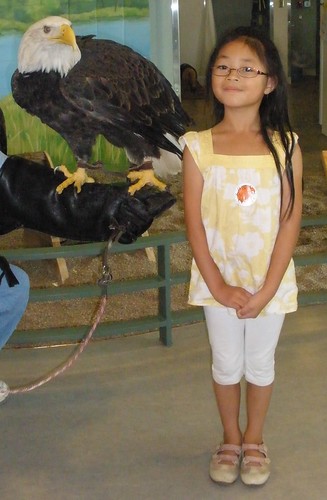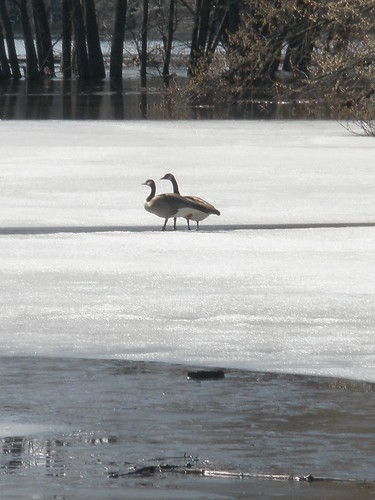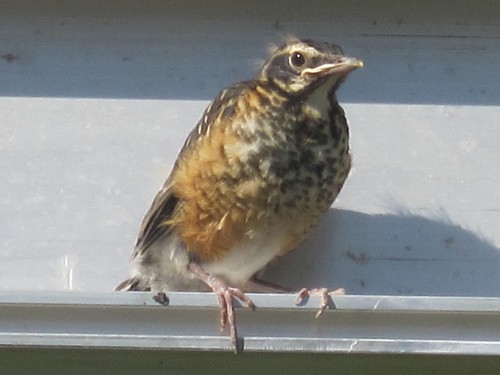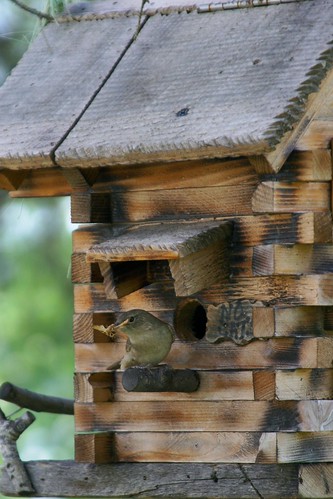The book features myths, legends, and superstitions related to 30 birds. The author lives in England so some of the birds are ones that live or migrate to that part of the world. However, there were quite a few North American birds that had fascinating stories associated with them.
Blackbird
There's a story about St. Kevin (498-618) who is an Irish saint similar in philosophy to St. Francis of Assisi. He preferred the company of animals to humans; and seemed to have a mystical command over them.
Once, during Lent, a blackbird landed on St. Kevin's outstretched hand and laid an egg there. Remaining perfecting still until the egg hatched, St. Kevin illustrated the character qualities of patience and gentleness.
Crossbill
I had never heard of a crossbill before, so it was interesting to read the story associated with this bird. Apparently, "...prior to [Jesus's crucifixion], it was held, crossbills had perfectly straight bills, but as Jesus hung above Golgotha, a crossbill swooped down and tried to help him by removing the nails.
"During this vain attempt, the crossbill's beak became twisted and its breast stained with Jesus's blood, hence its red plumage."
On the cross the dying Saviour
Heavenward lifts his eyelids calm,
Feels, but scarcely feels, a trembling
In his pierced and bleeding palm.
And by all the world forsaken,
Sees He how with zealous care
At the ruthless nail of iron
A little bird is striving there.
Stained with blood and never tiring,
With its beak it doth not cease,
From the cross ’t would free the Saviour,
Its Creator’s Son release.
And the Saviour speaks in mildness:
“Blest be thou of all the good!
Bear, as token of this moment,
Marks of blood and holy rood!”
And that bird is called the crossbill;
Covered all with blood so clear,
In the groves of pine it singeth
Songs, like legends, strange to hear.
Loon
Look we saw on Gunflint Lake in June 2013.
In some cultures, loons (also known as "divers") have been closely associated with both the beginning of the world and the end of life.
Eagle
Olivia next to an eagle in 2010 at the
National Eagle Center in Wabasha, Minnesota.
While eagles are considered to be strong and powerful birds, it it their vision that is often praised and singled out: "eagle-eyed" is still a widely-used phrase to describe someone who is incredibly meticulous and misses nothing.
The expression comes from the myth that eagles could look directly at the sun without blinking. Shakespeare referred to this myth in Henry VI, Part III (Act II, Scene I):
Nay if thou be that princely eagle's bird
Show thy descent by gazing 'gainst the sun.
I remember when I was growing up, my mom would often refer to my sister as having "eagle eyes" since she could find what my mom was searching for and/or needed. I never seemed possess that same quality.
Goose
Geese on ice in April 2011 at William O'Brien State Park.
In ancient China, a goose was considered to be a messenger between heaven and earth.
Throughout history geese have been widely sacrificed for grave offerings and on summer solstice. "The western tradition of eating roast goose at Michaelmas (September 29) may well have its origins in the sacrificial offerings of pagan times."
"Geese were also eaten on St. Martin's Night (November 11), an occasion on which the 'divination of the wishbone' or 'merry thought' took place: two people would pull the wishbone of the goose, and the person who broke off the larger piece could either make a wish or have the guarantee of good luck."
Magpie
In parts of Central Europe, it is believed that the magpie was the offspring of the dove and raven - the dove representing the positive aspects of the magpie's personality and significance, and the raven the negative.
Nightingale
St. Francis of Assisi, the founder of the Franciscan Order, was said to have sung duets with the nightingale.
Owls
Romans feared owls because they believed the birds were the messengers of death. The Pima Indians of Arizona believed that owls "contained the souls of the departed and that if an owl was heard hotting at the actual moment someone died it was a sign that it was waiting for that person's soul."
Pelican
Sophia, Olivia, and I were so excited to see a pelican in flight
in June 2012 at Lake Shetek State Park in southwestern Minnesota.
Robin
This is a juvenile robin that Sophia, Olivia, and I spotted
on June 9, 2012 in South Dakota.
In Greece, there's a legend that says that Jesus used to feed robins outside his parents' home. A close bond was formed between Jesus and the birds. Many years later, the "robin refused to leave Jesus's tomb until he had risen from the dead. It then sang with the angels as Jesus ascended to heaven."
Stork
This bird, in heraldry, represents filial duty and gratitude.
Swallow
Almost universally, the swallow is regarded as the herald of spring.
"The ancient Chinese...believed (just as the Romans did) that it was especially lucky if swallows nested on a house, and unlucky if they flew away. People even went to the length of erecting special nesting ledges to encourage the birds to stay."
Woodpecker
In Norse mythology, the woodpecker was the bird of Thor, god of lightening and thunder. "Just as Thor had red hair, so the woodpecker has a splash of red on its head.
"Thor had a magic hammer, Mjolnir; the woodpecker hammers on trees. Thor sent lightening to the earth, often striking trees; woodpeckers' holes resemble the holes made by lightning bolts."
Wren
The wren has some food for its babies who are in the house
in our backyard on June 6, 2008.
Every year we have one or two families of babies in this birdhouse.
One traditional saying warns that:
He that hurts a robin or a wren
Will never prosper on sea or land.
We enjoy seeing wrens during the spring, summer, and early-fall. My spirit is always lifted when I hear the wrens return and sing in the pine tree and apple trees right by the back of the house. They are the first birds I hear in the morning as I wake up. With such a beautiful song so enthusiastically sung, it makes getting up in the morning all that more pleasant.









No comments:
Post a Comment